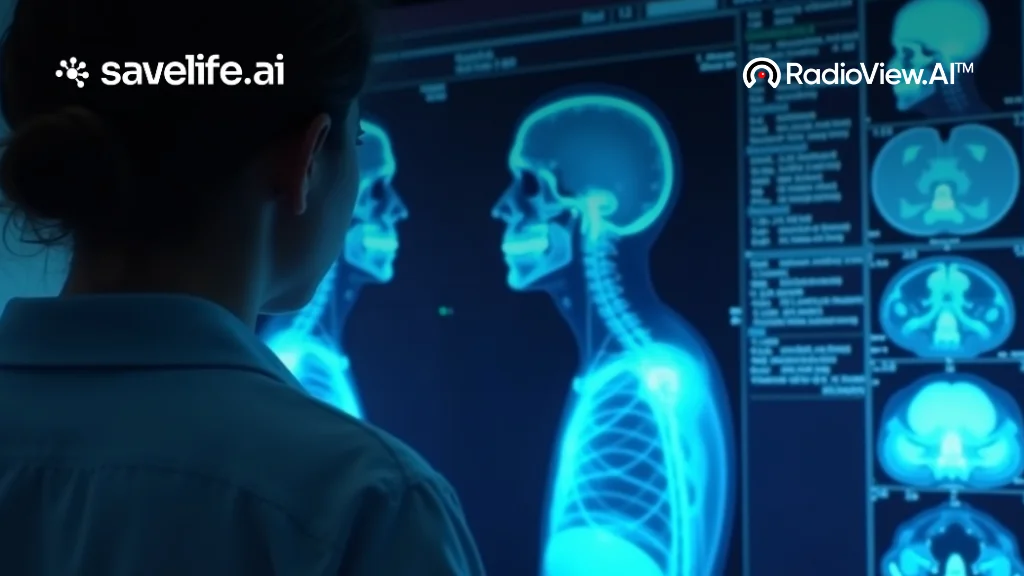The medical imaging landscape is transforming, thanks to AI-powered radiology reporting software. These advanced tools streamline workflow, enhance diagnostic accuracy, and significantly reduce radiologists’ reporting time. As technology evolves, hospitals and diagnostic centers are rapidly integrating AI in radiology to overcome challenges related to efficiency, consistency, and data integration.
Among the leading innovations in this space is RadReport by RadioView.AI, an Automated Radiology Report Generation (ARRG) system that seamlessly integrates with Picture Archiving and Communication Systems (PACS). This state-of-the-art tool sets new benchmarks in radiology by automating diagnostic processes, ensuring compatibility across different imaging infrastructures, and delivering precise reports.
Why Radiology Needs AI-Powered Reporting Software
Radiologists face increasing workloads as imaging technologies generate massive volumes of data. Manual interpretation and report generation can be time-consuming and prone to variability. AI-driven radiology reporting software addresses these challenges in the following ways:
Automating Radiology Report Generation – AI algorithms analyze imaging data, extract critical findings, and generate structured reports within seconds.
Enhancing Diagnostic Accuracy – Machine learning models trained on vast datasets help identify anomalies with better precision than traditional methods.
Reducing Radiologist Burnout – By automating repetitive tasks, radiologists can focus on complex cases and clinical decision-making.
Ensuring Standardization – AI in radiology ensures consistent reporting formats, minimizing variability across radiologists.
Key Features of AI-Based Radiology Reporting Software
The best radiology reporting software is characterized by a suite of advanced features that simplify workflows and improve accuracy:
1. AI-Powered Image Analysis
AI models trained on large imaging datasets can recognize patterns, detect anomalies, and assist radiologists in making quicker, more confident diagnoses.
2. Seamless PACS Integration
Modern software solutions integrate smoothly with PACS systems, ensuring imaging data is directly analyzed and reported without additional manual intervention.
3. Structured and Customizable Reporting
AI-generated reports follow structured formats, ensuring clarity, consistency, and compliance with RSNA (Radiological Society of North America) standards. Additionally, customizable templates allow radiologists to adjust reports as needed.
4. Enhanced Workflow Automation
AI-driven automation reduces the manual workload by performing repetitive tasks, such as:
- Auto-populating common findings
- Generating differential diagnoses
- Suggesting next-step recommendations
5. Speech-to-Text and Natural Language Processing (NLP)
Upcoming advancements include voice recognition and NLP capabilities, enabling radiologists to dictate reports in real-time while AI refines and structures them accordingly.
6. Cloud-Based Accessibility and Data Security
Many AI-powered reporting systems offer cloud-based platforms, allowing remote access while maintaining HIPAA-compliant security measures.
Real-World Benefits of AI in Radiology Reporting
The integration of AI in radiology is yielding measurable improvements across hospitals and imaging centers.
1. Faster Report Turnaround Times
Traditional reporting methods take hours, whereas AI-driven systems can generate preliminary reports in minutes, allowing physicians to make quicker decisions.
2. Improved Diagnostic Confidence
With AI-assisted detection and analysis, radiologists can cross-verify their findings, reducing the likelihood of errors and missed diagnoses.
3. Enhanced Collaboration and Second Opinions
Cloud-based AI tools facilitate seamless collaboration, enabling specialists to review, edit, and approve reports remotely.
4. Cost Reduction in Radiology Departments
Automation minimizes redundant work and optimizes radiology staff efficiency, leading to cost savings in the long run.
AI is the Future of Radiology
AI-driven radiology reporting software revolutionizes medical imaging by enhancing efficiency, accuracy, and collaboration. Tools like RadReport by RadioView.AI demonstrate how cutting-edge Automated Radiology Report Generation (ARRG) systems can seamlessly integrate with existing PACS, reduce reporting latency, and improve diagnostic precision.
As AI continues to evolve, radiology departments that embrace these innovations will be at the forefront of medical excellence, ensuring faster diagnoses, improved patient outcomes, and greater operational efficiency.
FAQs
- What is radiology reporting software?
Radiology reporting software provides structured templates to help radiologists document findings from X-rays, MRIs, and CT scans. These templates ensure consistency and accuracy in reports. - What software do radiologists use?
Radiologists mainly use PACS and RIS software, reporting tools, mammography information systems (MIS), peer review software, and aggregators. These tools streamline image capture, diagnosis, and reporting. - What is the main component of a radiology report?
A radiology report typically includes details about the anatomy examined, key findings, diagnostic impressions, and recommendations. It can be formatted as free text or structured data. - Where is AI used in radiology?
AI assists in creating study protocols and optimizing hanging protocols based on clinical parameters, helping radiologists analyze images more efficiently. - Will AI replace radiologists?
AI will not replace radiologists but enhance their abilities, improving diagnostic accuracy and efficiency. Those who adopt AI will be at the forefront of healthcare innovation.


